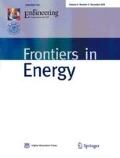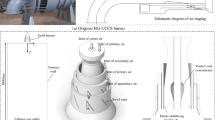Abstract
To improve the ignition behavior and to reduce the high NOx emissions of blended pulverized fuels (PF) of semicoke (SC), large-scale experiments were conducted in a 300 kW fired furnace at various nozzle settings, i.e., ratios (denoted by hf/b) of the height of the rectangular burner nozzle to its width of 1.65, 2.32, and 3.22. The combustion tests indicate that the flame stability, ignition performance, and fuel burnout ratio were significantly improved at a nozzle setting of hf/b = 2.32. The smaller hf/b delayed ignition and caused the flame to concentrate excessively on the axis of the furnace, while the larger hf/b easily caused the deflection of the pulverized coal flame, and a high-temperature flame zone emerged close to the furnace wall. NOx emissions at the outlet of the primary zone decreased from 447 to 354 mg/m3 (O2 = 6%), and the ignition distance decreased from 420 to 246 mm when the hf/b varied from 1.65 to 3.22. Furthermore, the ratio (denoted by SR/SC) of the strong reduction zone area to the combustion reaction zone area was defined experimentally by the CO concentration to evaluate the reduction zone. The SR/SC rose monotonously, but its restraining effects on NOx formation decreased as hf/b increased. The results suggested that in a test furnace, regulating the nozzle hf/b conditions sharply reduces NOx emissions and improves the combustion efficiency of SC blends possessing an appropriate jet rigidity.
Similar content being viewed by others
Abbreviations
- PF:
-
Pulverized fuels
- SC:
-
Semicoke
- PA:
-
Primary air
- SA:
-
Secondary air
- NOx :
-
Nitrogen oxides
- O2 :
-
Oxygen
- CO:
-
Carbon monoxide
- HCN:
-
Hydrogen cyanide
- BCR:
-
Bias concentration ratio
- CFD:
-
Computational fluid dynamics
- DTFs:
-
Drop tube furnaces
- PBCS:
-
Pilot-scale bias combustion simulator
- FTIR:
-
Fourier transform infrared
- NELRECC:
-
National Engineering Laboratory for Reducing Emissions from Coal Combustion
- HIT:
-
Harbin Institute of Technology
- x :
-
Distance between the measuring point and the burner outlet for the axial direction/mm
- r :
-
Distance between the measuring point and the burner outlet for the radial direction/mm
- h f :
-
Burner’s primary-air nozzle height/mm
- b :
-
Total burner’s primary-air nozzle width without nozzle distance/mm
- h f/b :
-
Height to width ratio
- S R :
-
The high reduction zone area/mm
- S C :
-
The combustion zone area/mm
- S R/S C :
-
The high reduction zone area to combustion zone area ratio
References
Yao H, He B, Ding G, et al. Thermogravimetric analyses of oxy-fuel co-combustion of semi-coke and bituminous coal. Applied Thermal Engineering, 2019, 156(6): 708–721
Zhang J, Jia X, Wang C, et al. Experimental investigation on combustion and NO formation characteristics of semi-coke and bituminous coal blends. Fuel, 2019, 247(7): 87–96
Smrekar J, Potočnik P, Senegačnik A. Multi-step-ahead prediction of NOx emissions for a coal-based boiler. Applied Energy, 2013, 106 (6): 89–99
Xu M, Yuan J, Ding S, et al. Simulation of the gas temperature deviation in large-scale tangential coal fired utility boilers. Computer Methods in Applied Mechanics and Engineering, 1998, 155(3–4): 369–380
Vuthaluru H B, Vuthaluru R. Control of ash related problems in a large scale tangentially fired boiler using CFD modeling. Applied Energy, 2010, 87(4): 1418–1426
Liu Y, Fan W, Li Y. Numerical investigation of air-staged combustion emphasizing char gasification and gas temperature deviation in a large-scale tangentially fired pulverized-coal boiler. Applied Energy, 2016, 177(9): 323–334
Guo J, Liu Z, Hu F, et al. A compatible configuration strategy for burner streams in a 200 MWe tangentially fired oxy-fuel combustion boiler. Applied Energy, 2018, 220(6): 59–69
Habib M A, Ben-Mansour R, Abualhamayel H I. Thermal and emission characteristics in a tangentially fired boiler model furnace. International Journal of Energy Research, 2010, 34(13): 1164–1182
Tang G, Wu B, Johnson K, et al. Numerical study of a tangentially fired boiler for reducing steam tube overheating. Applied Thermal Engineering, 2016, 102(6): 261–271
Khatami R, Stivers C, Joshi K, et al. Combustion behavior of single particles from three different coal ranks and from sugar cane bagasse in O2/N2 and O2/CO2 atmospheres. Combustion and Flame, 2012, 159(3): 1253–1271
Riaza J, Khatami R, Levendis Y A, et al. Single particle ignition and combustion of anthracite, semi-anthracite and bituminous coals in air and simulated oxy-fuel conditions. Combustion and Flame, 2014, 161(4): 1096–1108
Khatami R, Levendis Y A. An overview of coal rank influence on ignition and combustion phenomena at the particle level. Combustion and Flame, 2016, 164(2): 22–34
Zhu M, Zhang H, Tang G, et al. Ignition of single coal particle in a hot furnace under normal and micro-gravity condition. Proceedings of the Combustion Institute, 2009, 32(2): 2029–2035
Su S, Pohl J H, Holcombe D, et al. Techniques to determine ignition, flame stability and burnout of blended coals in p.f. power station boilers. Progress in Energy and Combustion Science, 2001, 27(1): 75–98
Clements B R, Zhuang Q, Pomalis R, et al. Ignition characteristics of co-fired mixtures of petroleum coke and bituminous coal in a pilot-scale furnace. Fuel, 2012, 97(2): 315–320
Zeng G, Sun S, Dong H, et al. Effects of combustion conditions on formation characteristics of particulate matter from pulverized coal bias ignition. Energy & Fuels, 2016, 30(10): 8691–8700
Zeng G, Sun S, Yang X, et al. Effect of the primary air velocity on ignition characteristics of bias pulverized coal jets. Energy & Fuels, 2017, 31(3): 3182–3195
Zeng G, Sun S, Zhang W, et al. Effects of bias concentration ratio on ignition characteristics of parallel bias pulverized coal jets. Energy & Fuels, 2017, 31(12): 14219–14227
Zhao Y, Zeng G, Zhang L, et al. Effects of fuel properties on ignition characteristics of parallel-bias pulverized-coal jets. Energy & Fuels, 2017, 31(11): 12804–12814
Qin Y, Zhang Z, Wu S, et al. Experimental study of jet characteristics of a rectangular nozzle with different height-to-width ratios in a tangentially-fired combustion flow field. Journal of Engineering for Thermal Energy and Power, 2000, 15(2): 125–127 (in Chinese)
Zhang J, Kelly K E, Eddings E G, et al. Ignition in 40 kW co-axial turbulent diffusion oxy-coal jet flames. Proceedings of the Combustion Institute, 2011, 33(2): 3375–3382
Binner E, Zhang L, Li C, Bhattacharya S. In-situ observation of the combustion of air-dried and wet Victorian brown coal. Proceedings of the Combustion Institute, 2011, 33(2): 1739–1746
Molina A, Murphy J J, Winter F, et al. Pathways for conversion of char nitrogen to nitric oxide during pulverized coal combustion. Combustion and Flame, 2009, 156(3): 574–587
Yan Y, Sun L, Peng Z, et al. Effects of pyrolyzed semi-char blend ratio on coal combustion and pollution emission in a 0.35 MW pulverized coal-fired furnace. Frontiers in Energy, 2020, online, doi: https://doi.org/10.1007/s11708-020-0678-z
Rastko J, Aleksandra M, Bartosz S. Sensitivity analysis of different devolatilization models on predicting ignition point position during pulverized coal combustion in O2/N2 and O2/CO2 atmospheres. Fuel, 2012, (11): 23–37
Ti S, Chen Z, Li Z, et al. Influence of primary air cone length on combustion characteristics and NOx emissions of a swirl burner from a 0.5 MW pulverized coal-fired furnace with air staging. Applied Energy, 2018, 211(2): 1179–1189
Qiao Y, Zhang L, Binner E, et al. An investigation of the causes of the difference in coal particle ignition temperature between combustion in air and in O2/CO2. Fuel, 2010, 89(11): 3381–3387
Sung Y, Moon C, Eom S, et al. Coal-particle size effects on NO reduction and burnout characteristics with air-staged combustion in a pulverized coal-fired furnace. Fuel, 2016, 182(10): 558–567
Chen Z, Li Z, Jing J, et al. Gas/particle flow characteristics of two swirl burners. Energy Conversion and Management, 2009, 50(5): 1180–1191
Jiang X, Zheng C, Yan C, et al. Physical structure and combustion properties of super fine pulverized coal particle. Fuel, 2002, 81(4): 793–797
Li Z, Liu Y, Chen Z, et al. Effect of the air temperature on combustion characteristics and NOx emissions from a 0.5 MW pulverized coal-fired furnace with deep air staging. Energy & Fuels, 2012, 26(4): 2068–2074
Pedel J, Thornock J N, Smith P J. Large eddy simulation of pulverized coal jet flame ignition using the direct quadrature method of moments. Energy & Fuels, 2012, 26(11): 6686–6694
Yamamoto K, Murota T, Okazaki T, et al. Large eddy simulation of a pulverized coal jet flame ignited by a preheated gas flow. Proceedings of the Combustion Institute, 2011, 33(2): 1771–1778
Zhu Z, Chi Z, Pan W, et al. Aerodynamic experimental research in corner-fired furnace with burners of different height-width ratios. Journal of Shanghai Institute of Electric Power, 1994, 10(1): 20–27 (in Chinese)
Wang C, Hao Y, Wang R, et al. Numerical simulation of influence of depth-width ratio for boiler burner on combustion. Gas & Heat. 2010, 30(12): 11–15 (in Chinese)
Moon C, Sung Y, Eom S, et al. NOx emissions and burnout characteristics of bituminous coal, lignite, and their blends in a pulverized coal-fired furnace. Experimental Thermal and Fluid Science, 2015, 62(1): 99–108
Glarborg P, Kristensen P, Dam-Johansen K, et al. Nitric oxide reburning by non-hydrocarbon fuels: implications for reburning with gasification gases. Energy & Fuels, 2000, 14(4): 828–838
Gou X, Zhou J, Zhou Z, et al. The influence of water vapor upon formation of NO in combustion of pulverized coal. Thermal Power Generation, 2007, 10(1): 4–8 (in Chinese)
Wang Z, Zhao Y, Sun R, et al. Effects of reaction condition on NO emission characteristic, surface behavior and microstructure of demineralized char during O2/H2O combustion process. Fuel, 2019, 253(10): 1424–1435
De Soete G, Croiset E, Richard J R. Heterogeneous formation of nitrous oxide from char-bound nitrogen. Combustion and Flame, 1999, 117(1–2): 140–154
Acknowledgements
This work was supported by the National Key Research and Development Program of China (No. 2017YFB0602002) and National Natural Science Foundation of China (Grant No. 51536002).
Author information
Authors and Affiliations
Corresponding author
Rights and permissions
About this article
Cite this article
Sun, L., Yan, Y., Sun, R. et al. Influence of nozzle height to width ratio on ignition and NOx emission characteristics of semicoke/bituminous coal blends in a 300 kW pulverized coal-fired furnace. Front. Energy 15, 431–448 (2021). https://doi.org/10.1007/s11708-021-0726-3
Received:
Accepted:
Published:
Issue Date:
DOI: https://doi.org/10.1007/s11708-021-0726-3



